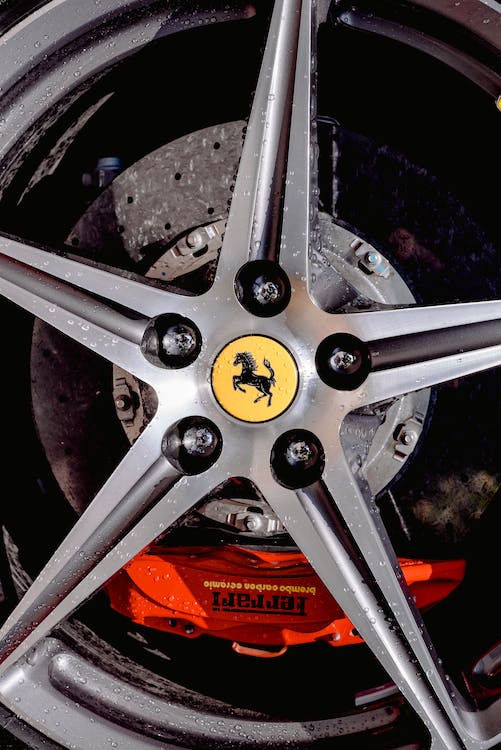In motorsports, the showcase of Formula 1 is a real laboratory for new technologies. Ceramic brakes are one of them. But what is this innovation whose name evokes more fragility than performance? And what will it mean for the average driver’s car? Find out all about ceramic brakes.
Car braking system and its limits
A vehicle accumulates kinetic energy while driving; it is a potential energy which is transformed into destructive energy during an accident against an obstacle or which takes the form of heat energy when the brakes are activated to slow down or stop the car.
The rise in temperature of the brakes is, therefore, a normal phenomenon, and the problem lies in the capacity of the braking system to dissipate this heat into the ambient air. The limit is reached during heavy or prolonged braking, where the heat can deteriorate the seals of the brake pistons, the brake discs and boil the brake fluid (fading), making them inoperative.
Technical solutions: carbon or ceramic brakes
To dissipate the heat, various corrective solutions exist. The simplest and least expensive are the ventilated or perforated discs.
– The ventilated disc: it has 2 layers between which air circulates for better cooling.
– The perforated disc: several holes are scattered on the surface of the discs for better cooling.
The replacement of steel discs with carbon or ceramic discs is also an effective alternative, the restriction for carbon discs being their prior heating to be functional.
Focus on ceramic brakes

This type of brake, which has nothing to do with the traditional ceramic material, is made of composite ceramic. These are carbon structure brakes to which silica extracts are added. When heated in an oven, these discs acquire a hardness close to that of a diamond.
Advantages of ceramic brakes
Ceramic discs have considerable qualities.
– A capacity of operation at high temperatures (up to 1000°C). In addition, the fact that they do not radiate heat preserves the life of neighbouring components and fluids (brake callipers, brake fluid, hubs, grease for hubs and transmissions, etc.).
– A long life. Due to their hardness quality, the life span is equivalent or superior to that of the vehicle, thus 5 to 10 times longer than standard discs (for comparison, a set of steel discs is replaced on average every 50,000 km).
– A great lightness (3 times lighter than traditional discs). This is an important factor for unsprung masses (wheels and brakes).
– Powerful and efficient braking at all temperatures (a quality that follows from the previous strengths).
Disadvantages of ceramic brakes
Although ceramic brakes are a revolution, their use on mass-produced vehicles is not yet a reality for two main reasons:
– The cost: it is exorbitant. For example, a ceramic brake pack (discs + callipers) for an Audi RS 6 reaches $10 000. The main reason is the extremely technical and time-consuming manufacturing process:
◦ a porous carbon fibre matrix is gradually enriched and filled with composite materials after various formatting and oven stages;
◦ the resulting part must approach the final dimensional characteristics as closely as possible;
◦ the last step consists in adding silica-based components to obtain, after a final steaming, a hardness close to diamond, which complicates the last grinding operation of the disc intended to bring it precisely to its final dimension.
– The elitism due to the cost, the manufacturing process and the very restrictive number of firms capable of producing ceramic brakes. The main developers are Brembo, and Carbone Lorraine for the optional equipment of prestigious brands and models and for racing teams.
Here are some examples of available assemblies (the average price of a set of discs is $3,500):
|
Brand |
Model |
|---|---|
|
Porsche |
997 GT3 |
|
Ferrari |
F360 – F430 |
|
BMW |
M3 – 1M – Z8 |
|
Maserati |
Gran Tourismo |
|
Mercedes |
C63 AMG |
|
Chevrolet |
C6 Z06 |
Ceramic brakes on mass-produced cars?
As mentioned, the vehicles currently equipped with ceramic brakes (as an option) are prestige and luxury vehicles, as well as competition prototypes.
Mass-produced cars will have to wait a few more years. The evolution towards more flexible manufacturing processes and lower costs is the first condition: if mass production lowers costs, they will always be higher than traditional brake discs (a set of steel discs costs $50 to $150).
If the arguments of safety by their performance lean in favour of ceramic discs, traditional braking systems have evolved a lot, helped by assistance devices (anti-lock brakes, tire adhesion, new technologies related to electric and hybrid vehicles, such as energy recovery during braking, which allow using the brakes less).
Hope you like this new post on ceramic brakes. Remember to leave your comments below.





One thought on “Ceramic Brakes: Everything You Need to Know”